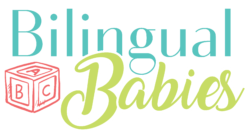Ever heard people say something like “Yeah, we are doing OPOL”. And while you smile and nod at the person, your head goes “What?” At least that was my reaction when I first heard all of the acronyms associated with different models of bilingual living. Overall, there are four main models or ways of how bilingual families include different languages in their daily lives:
-
One-parent-one-language (OPOL)
The OPOL strategy is pretty much what the name already says. Each parent speaks one language to the child that is different from the language the other parent speaks. In a nutshell: one language per parent.
According to research, this is the most common form of bilingual living (e.g., Barron-Hauwaert, 2004) and it’s what we have been doing in our family. So, I speak German to our daughter and my husband speaks English to her. So we each speak our native language to her, thus exposing her to the two languages.
-
Minority language at home (mL@H)
In the case of mL@H, both parents speak the minority language at home (either both are native speakers of the minority language or not). The family we bought our house from is a prime example. Both parents were from different parts of Germany, but they lived and raised their children in New Jersey. So they spoke German with the children at home and English outside the home. Obviously, this works only if both parents actually speak the minority language.
The advantage for mL@H is that the child gets much more exposure to the minority language and, speaking from experience, there are probably much fewer misunderstandings because both parents understand at all times what is being said and are thus on the same page (at least in theory ;-)).
- Time and place (T&L)
As the name says, T&L means that you use the target or minority language at certain times or in certain places. T&L is most often used in bilingual school programs (e.g., mornings in French, afternoons in English), but it can also be applied to family life. For example, in your family you can have Spanish weekends, French Wednesdays, or Chinese story time before bed. It may seem somewhat similar to mL@H, but it’s more of a conscious departure from it because you are consciously dedicating a given time or place to the use of the minority language.
- Mixed Language Policy (MLP)
The final category is MLP. As the label says, families who adopt MLP mix languages all the time depending on the topic or situation at hand. So parents use a language that fits a particular topic or situation. For example, they may talk about what happened at school in English, then switch to Spanish when talking about Aunt Roberta’s visit the following weekend.
This model is most common in certain areas like Miami, India, Singapore, and Indonesia (Pearson, 2008). Researchers found that families or parents who live MLP feel that this is the natural way for them; any forced monolingual conversation would feel unnatural.
Which model is best?
None! No one method or model of bilingual living works better than the other. You have to figure out what works best for your situation and for you as a family.
Personally, I would caution against MLP for the following reason: a child needs to have enough exposure to the minority language. Experts say that at least 20-23% of a child’s waking hours (i.e., 15-25 hours per week) should be filled with exposure to the minority language. So, for us as a family living in New Jersey, I would not want to leave it up to chance that Ella gets enough exposure to German because our majority language (English) will most likely win and drown out German. However, if your child gets enough exposure to both or more languages, then MLP might be okay for you.
Oftentimes families have found that it even makes sense to switch from one model to another. For example, when you move to another country and the minority language all of a sudden becomes the majority language. So if we ever moved to Germany, we would most likely switch from OPOL to mL@H to maximize the English exposure for Ella so she would be able to keep up her English. Models can also be combined: OPOL during the week and mL@H on the weekends or you switch from T&L to mL@H when a friend or family member visits who speaks the minority language. Also when you have more than two languages spoken in your house, then a mix of models might work best (e.g., OPOL for the parents’ native languages and T&L for the third minority language). So consistency, not rigidity is key!
So bottom line: There is no “best” or “most successful” model. Find the approach that works for you and try to maximize your child’s exposure to the minority language(s) while keeping things fun and engaging.
Further reading:
- De Houwer, A. (2007). Parental language input patterns and children’s bilingual use. Applied Psycholinguistics 28, 411–424.
- Pearson, B. Z. (2008). Raising a bilingual child: A step-by-step guide for parents. New York: Random House.
- Barron-Hauwaert, S. (2004). Language strategies for bilingual families: The one-parent-one-language approach. Clevedon, UK: Multilingual Matters.

